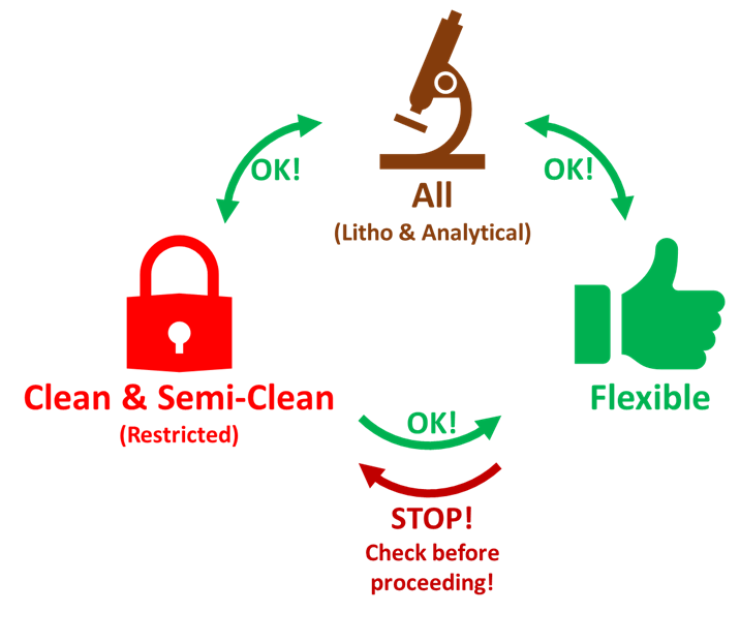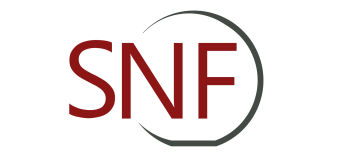Cleanliness Groups for Process Flows
Overview

Cleanliness groups are used to classify equipment and materials at SNF to minimize cross-contamination risk. The choice of equipment in a process sequence will depend on the previous equipment used as well as the materials in your samples. In general, wafers can be processed in only equipment within the same or lower level of cleanliness. So, for example, this sequence: Clean -> Semi-Clean -> Flexible, is acceptable, but the reverse is not unless extra steps are taken. Equipment in the "All" group present low risk of cross-contamination because subsequent cleaning procedures remove surface contaminants. Wafers retain their classification when processed in any of the "All" group equipment; in other words, a Semi-Clean wafer is still Semi-Clean after processing in lithography. Any questions, please discuss with a staff member or contact the PROM committee.
Clean
Equipment supporting "front-end" CMOS device processing, before metallization, may fall into this group, which has the lowest tolerance for metal contaminants.
- Color code: RED
- Materials restrictions: CMOS compatible substrates and film materials only. Wafers containing any metals or metal films are strictly prohibited from being processed in this equipment. For details, refer to the Materials List.
- Previous equipment:
- Clean equipment group. Wafers with any previous processing in Clean equipment can be processed in Clean tools without further consideration.
- Semi-Clean and Flexible equipment. Wafers with any previous processing in Semi-Clean and Flexible equipment will require additional considerations before returning to Clean tools. Such considerations may include procedures before processing in the previous equipment (such as chamber coating) or post-processing procedures (such as decontamination.) Consult the operating procedures for the specific equipment previously used.
- "All" Equipment. Wafers previously processed in any "All" equipment are acceptable for processing (following appropriate photoresist restrictions or resist stripping procedures).
- Next equipment: Subject to materials restrictions, wafers may subsequently be processed in any equipment of all other categories.
- Additional process restrictions: Processing in any of the flexible wet benches must be done with appropriately dedicated clean labware to prevent cross-contamination.
Semi-Clean
Equipment supporting "back-end" CMOS device processing may fall into this group, where wafers containing metals commonly found in "back-end" devices are processed. Acceptable metals are generally those that have low diffusion rates in silicon at elevated temperatures or form stable silicides so they don't diffuse or do not form deep-level traps in silicon devices.
- Color code: RED
- Materials restrictions: CMOS-compatible substrates and film materials only. For details, refer to the Materials List.
- Semi-Clean A. Wafers may contact standard metals: Aluminum (Al), Tungsten (W), and Titanium (Ti)
- Semi-Clean B. In addition, wafers may contain these metals if deposited using the Intlvac evaporator or the Lesker sputter #2 (special permission is required for any other metal deposition system): Ni, Co, Pt, Al, Hf, Ta, Mo, W, Ti, Cr, Zr, Pd
- Previous equipment:
- Clean and Semi-Clean equipment. Wafers with any previous processing in Clean and Semi-Clean equipment can be processed in Semi-Clean tools without further consideration.
- Flexible equipment. Wafers with any previous processing in Flexible equipment may require additional considerations before returning to Semi-Clean tools. Such considerations may include procedures before processing in the previous equipment (such as chamber coating) or post-processing procedures (such as decontamination.) Consult the operating procedures for the specific equipment used.
- " All Equipment. Wafers previously processed in any "All" equipment are acceptable for processing (following appropriate photoresist restrictions or resist stripping procedures).
- Next equipment: Subject to materials restrictions, wafers may subsequently be processed in any equipment in the Semi-Clean, Flexible, and All categories
- Additional process restrictions:
- Semi-Clean B wafers must be cleaned or wet-etched using dedicated Semi-Clean labware at the wbflexcorr-3and-4 or wbflexcorr-1and-2 benches (i.e., do not use wbmetal baths.)
- Semi-Clean B wafers may be etched in Semi-Clean plasma etch tools provided the Semi-Clean B film is not being etched. Etching other films and stopping on Semi-Clean B films is OK. However, dry etching of Semi-Clean B films is permitted only on a case-by-case basis.
MOCVD Clean
MOCVD is categorized as a contaminated tool in traditional Complementary metal-oxide-semiconductor (CMOS) processing in general, but it has a low tolerance for external contamination due to the high growth temperature and stringent requirements for epitaxial CVD. In the SNF, we have a category called “MOCVD clean” which only accepts clean substrates. The two tools that fall into this category are the aix-ccs MOCVD and aix200 MOCVD.
- Color Code: None (restricted to the MOCVD lab.)
- Materials restrictions:
- For aix-ccs, only clean (metal and organic free) Si, SiC, Sapphire and GaN substrates are allowed.
- For aix200, only clean Si and III-V substrates like GaAs, InP, GaP et al. are allowed in “clean” period.
- Wafers containing any other materials requires ProM review and obtain approval. For details, refer to the Materials List.
- Previous equipment:
- " All Equipment. Wafers with any previous processing in any "All" equipment are acceptable for processing (following appropriate photoresist restrictions or resist stripping procedures).
- Wafers with any previous processing in any other equipment, other than pre-MOCVD deposition cleaning, requires ProM review and approval.
- Next equipment. Because of materials compatibility with silicon CMOS, samples processed in the MOCVD tools may subsequently be processed only in Flexible or All equipment.
- Additional process restrictions. Processing at any of the wet benches must be done with appropriately dedicated labware (clean quartz or Teflon only) to prevent cross-contamination.
Flexible
Most equipment in the lab is in this Flexible equipment group. Clean and Semi-Clean processing can be accommodated in most Flexible equipment, with additional procedures to protect against contamination that affects device performance.
- Color code: GREEN
- Materials restrictions: None, subject to the Materials List.
- Previous equipment: No restrictions, subject to specific equipment operations.
- Next equipment:
- Wafers with previous processing in Clean or Semi-Clean equipment that will be subsequently processed in Clean or Semi-Clean equipment will require additional considerations for processing in Flexible tools. Such considerations may include additional procedures, such as chamber coating or cleaning, or other post-Flexible tool processing procedures (such as decontamination.) Consult the operating procedures for the specific Flexible tool used.
- In absence of Clean or Semi-Clean considerations, wafers processed in Flexible equipment can only be processed further in Flexible or All (Litho/Analytical) equipment.
- Additional process restrictions: Processing in any of the flexible wet benches must be done with appropriately dedicated clean labware to prevent cross-contamination.
All
Most lithography and analytical tools appear in the "All" group. Cross-contamination risk in these tools is low because subsequent processing (namely, resist removal and pre-deposition cleans) prior to high temperature processing serves to remove possible surface contaminants that may have transferred. In general, the category of a wafer remains unchanged by processing in equipment in the "All" group. (So, for example, a wafer coming from a "Clean" tool into the lithography area can return to another "Clean" tool, following standard resist strip and cleaning.)
- Color code: BROWN
- Materials restrictions: Check the Materials list for specific approved/restricted materials.
- Previous equipment: Wafers retain their cleanliness category from previous equipment used.
- Next equipment: If your process does not include conventional resist removal and cleans prior to high temperature processing in restricted equipment (Clean, Semi-Clean, MOCVD), make sure to discuss your process needs with the PROM committee.
- Other process concerns: Note that the stylus profilometers are not in the "All" group because of the physical contact of the stylus with the wafer front-side.
Wet Benches
Wet benches are the first line of defense for protecting against cross-contamination. But a contaminated wet chemical bath is also the most effective means of spreading that contamination to any materials processed in that bath. Wet benches appear in all equipment groups. The use of designated and/or personal labware ensures that risks of cross-contamination are minimized.
Last modified: 25 Apr 2023


